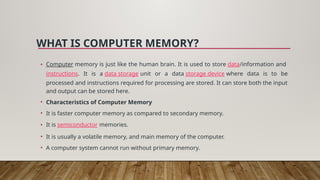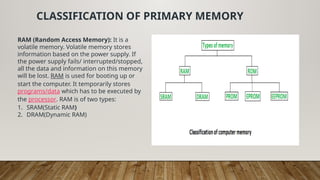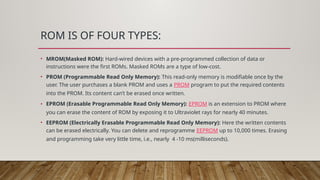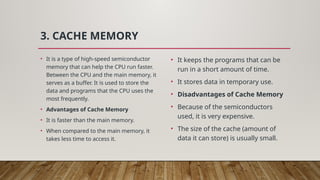Computer Memory.pptx with its types and storage
- 1. COMPUTER MEMORY ŌĆó INTRODUCTION ŌĆó TYPES
- 2. WHAT IS COMPUTER MEMORY? ŌĆó Computer memory is just like the human brain. It is used to store data/information and instructions. It is a data storage unit or a data storage device where data is to be processed and instructions required for processing are stored. It can store both the input and output can be stored here. ŌĆó Characteristics of Computer Memory ŌĆó It is faster computer memory as compared to secondary memory. ŌĆó It is semiconductor memories. ŌĆó It is usually a volatile memory, and main memory of the computer. ŌĆó A computer system cannot run without primary memory.
- 3. TYPES OF COMPUTER MEMORY In general, computer memory is of three types: ŌĆó Primary memory ŌĆó Secondary memory ŌĆó caches memory
- 5. 1. PRIMARY MEMORY ŌĆó Primary storage or memory is also known as the main memory, which is the part of the computer that stores current data, programs, and instructions. Primary storage is stored in the motherboard which results in the data from and to primary storage can be read and written at a very good pace ŌĆó It is also known as the main memory of the computer system. It is used to store data and programs or instructions during computer operations. It uses semiconductor technology and hence is commonly called semiconductor memory. Primary memory is of two types: Primary memory can be broadly classified into two parts: 1.Read-Only Memory (ROM) 2.Random Access Memory (RAM)
- 6. CLASSIFICATION OF PRIMARY MEMORY RAM (Random Access Memory): It is a volatile memory. Volatile memory stores information based on the power supply. If the power supply fails/ interrupted/stopped, all the data and information on this memory will be lost. RAM is used for booting up or start the computer. It temporarily stores programs/data which has to be executed by the processor. RAM is of two types: 1. SRAM(Static RAM) 2. DRAM(Dynamic RAM)
- 7. RAM IS OF TWO TYPES: ŌĆó S RAM (Static RAM): S RAM uses transistors and the circuits of this memory are capable of retaining their state as long as the power is applied. This memory consists of the number of flip flops with each flip flop storing 1 bit. It has less access time and hence, it is faster. ŌĆó D RAM (Dynamic RAM): D RAM uses capacitors and transistors and stores the data as a charge on the capacitors. They contain thousands of memory cells. It needs refreshing of charge on capacitor after a few milliseconds. This memory is slower than S RAM.
- 8. READ ONLY MEMORY ROM (Read Only Memory): It is a non- volatile memory.Non-volatile memory stores information even when there is a power supply failed/ interrupted/stopped. As its name refers to read-only memory, we can only read the programs and data that is stored on it. The information stored in the ROM in binary format. It is also known as permanent memory.
- 9. ROM IS OF FOUR TYPES: ŌĆó MROM(Masked ROM): Hard-wired devices with a pre-programmed collection of data or instructions were the first ROMs. Masked ROMs are a type of low-cost. ŌĆó PROM (Programmable Read Only Memory): This read-only memory is modifiable once by the user. The user purchases a blank PROM and uses a PROM program to put the required contents into the PROM. Its content canŌĆÖt be erased once written. ŌĆó EPROM (Erasable Programmable Read Only Memory): EPROM is an extension to PROM where you can erase the content of ROM by exposing it to Ultraviolet rays for nearly 40 minutes. ŌĆó EEPROM (Electrically Erasable Programmable Read Only Memory): Here the written contents can be erased electrically. You can delete and reprogramme EEPROM up to 10,000 times. Erasing and programming take very little time, i.e., nearly 4 -10 ms(milliseconds).
- 10. 2. SECONDARY MEMORY ŌĆó It is also known as auxiliary memory and backup memory. It is a non-volatile memory and used to store a large amount of data or information. The data or information stored in secondary memory is permanent, and it is slower than primary memory. A CPU cannot access secondary memory directly. The data/information from the auxiliary memory is first transferred to the main memory, and then the CPU can access it Use of Secondary memory ŌĆó Permanent storage: As we know that primary memory stores data only when the power supply is on, it loses data when the power is off. So we need a secondary memory to stores data permanently even if the power supply is off. ŌĆó Large Storage: Secondary memory provides large storage space so that we can store large data like videos, images, audios, files, etc permanently. ŌĆó Portable: Some secondary devices are removable. So, we can easily store or transfer data from one computer or device to another.
- 11. CHARACTERISTICS OF SECONDARY MEMORY ŌĆó It is a slow memory but reusable. ŌĆó It is a reliable and non-volatile memory. ŌĆó It is cheaper than primary memory. ŌĆó The storage capacity of secondary memory is large. ŌĆó A computer system can run without secondary memory. ŌĆó In secondary memory, data is stored permanently even when the power is off.
- 12. TYPES OF SECONDARY MEMORY ŌĆó 1. Magnetic Tapes: In magnetic tape only one side of the ribbon is used for storing data. It is sequential memory which contains thin plastic ribbon to store data and coated by magnetic oxide.Each track has one read/write head, which allows data to be recorded and read as a sequence of characters. It can be stopped, started moving forward or backward, or rewound. 1.These are inexpensive, i.e., low cost memories. 2.It provides backup or archival storage. 3.It can be used for large files. 4.It can be used for copying from disk files. 5.It is a reusable memory. 6.It is compact and easy to store on racks.
- 14. ŌĆó 2.magnetic Disk is a type of secondary memory that is a flat disc covered with a magnetic coating to hold information. It is used to store various programs and files. The polarized information in one direction is represented by 1, and vice versa. The direction is indicated by 0. ŌĆó These are economical memory Easy and direct access to data is possible. ŌĆó It can store large amounts of data. ŌĆó It has a better data transfer rate than magnetic tapes. ŌĆó It has less prone to corruption of data as compared to tapes.
- 16. TYPES OF OPTICAL DISKS ŌĆó CD ŌĆō ROM ŌĆó ItŌĆÖs called compact disk. Only read from memory. ŌĆó Information is written to the disc by using a controlled laser beam to burn pits on the disc surface. ŌĆó It has a highly reflecting surface, which is usually aluminium. ŌĆó The diameter of the disc is 5.25 inches. ŌĆó 16000 tracks per inch is the track density. ŌĆó The capacity of a CD-ROM is 600 MB, with each sector storing 2048 bytes of data. ŌĆó The data transfer rate is about 4800KB/sec. & the new access time is around 80 milliseconds. ŌĆó WORM-(WRITE ONCE READ MANY) ŌĆó A user can only write data once. ŌĆó The information is written on the disc using a laser beam. ŌĆó It is possible to read the written data as many times as desired. ŌĆó They keep lasting records of information but access time is high. ŌĆó It is possible to rewrite updated or new data to another part of the disc. ŌĆó Data that has already been written cannot be changed. ŌĆó Usual size ŌĆō 5.25 inch or 3.5 inch diameter. ŌĆó The usual capacity of 5.25 inch disk is 650 MB,5.2GB etc.
- 17. 3. CACHE MEMORY ŌĆó It is a type of high-speed semiconductor memory that can help the CPU run faster. Between the CPU and the main memory, it serves as a buffer. It is used to store the data and programs that the CPU uses the most frequently. ŌĆó Advantages of Cache Memory ŌĆó It is faster than the main memory. ŌĆó When compared to the main memory, it takes less time to access it. ŌĆó It keeps the programs that can be run in a short amount of time. ŌĆó It stores data in temporary use. ŌĆó Disadvantages of Cache Memory ŌĆó Because of the semiconductors used, it is very expensive. ŌĆó The size of the cache (amount of data it can store) is usually small.




























































